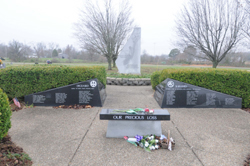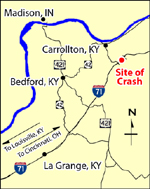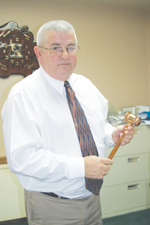



Lasting Impact
Carrollton
bus crash
has lingering effect 23 years later
New
documentary to be made on 1988 crash
prompts memories for those who were there
“There’s
never a time when people pass that sign
that they don’t think about that bus crash.
I don’t have to pass that sign to think about it.”
– Steve Meadows, retired EMT who worked the crash
By
Don Ward
Editor
 |
|
December
2011 |
CARROLLTON, Ky. (December 2011) – Harold “Shorty”
Tomlinson has collected many awards and photos during his long career
in public service and he displays them proudly in his office atop the
Carroll County Courthouse.
But there’s one item that the Judge-Executive treasures with mixed
emotions – the gavel used in the December 1989 Larry Mahoney
manslaughter trial.
Mahoney, then 34, was drunk when he drove his Toyota pickup truck head-on
into a school bus carrying a Radcliff, Ky., church group of 67 people
home from a day at King’s Island amusement park. Mahoney, who had
a blood alcohol level of .24 – more than twice the legal limit
at the time – was driving the wrong way on I-71 while returning
to his home in Owen County around 11 p.m. The truck pinned the front
door of the bus shut and the gas tank exploded into flames. Most of
the 27 victims burned to death because they could not escape in time
through the only exit in the back of the bus. Of those aboard the bus,
24 children and three adults died. Forty survived but 12 of them were
severely burned. The crash still ranks today as the nation’s deadliest
alcohol-related traffic accident.
A film company in Lexington, Ky., recently began working on a documentary
about the bus crash and how it changed the lives of its victims and
survivors. “Impact – After the Crash” is scheduled to
be complete late next year with release in early 2013.
Mahoney, a factory worker, was convicted of manslaughter and sentenced
to 16 years in prison. A model prisoner, he served 10 years, 11 months
at the La Grange, Ky., Reformatory before his release in 1999.
Judge Charles Satterwhite, now deceased, presided over
the trial and borrowed the gavel from Tomlinson, a county magistrate
at the time. The courthouse was in the process of moving to a new location
across town, and many of Satterwhite’s belonging, including his
gavel, were packed away. Tomlinson loaned him the gavel and that was
the only time it has been used. The trial was the last one ever held
in the Carroll County Courthouse. The court moved across town right
after the trial.
Tomlinson pauses and chooses his words wisely when discussing his feelings
about that time, about his childhood friend, Mahoney, and about the
many “negative things that were said about Carroll County”
in the media during the coverage of the trial.
“I’ve known Larry Mahoney all my life, and I know he would
give his own life to bring just one of those kids back – he’s
that kind of person,” said Tomlinson, 62. “It was a horrible
thing that happened, but it happened and we all have to deal with it.”
The stings of heartbreak from the horrific bus crash and the resulting
harsh criticism toward his hometown still linger in Tomlinson’s
mind.
“It was a horrible thing, any way you look at it,” he says
while holding the gavel and recalling those unpleasant events that still
haunt Carroll County. What’s more, a green highway sign still stands
to this day along rural I-71 in Carroll County marking the site of the
crash.
 |
|
Photo
courtesy of Neal Cardin of The News Enterprise This
memorial dedicated to the 27 |
Soon after Tomlinson took office as Judge-Executive in
1990, one of the first things he did was ask the Kentucky State Transportation
Cabinet to remove the sign. But protesters from Radcliff quickly arrived,
and his request was denied.
“They showed up in a minute, so the sign stayed up,” he recalled.
Tomlinson says his attempt to remove the sign was because of his concerns
for public safety. So many people were stopping their cars along the
interstate to lay flowers or take photos of the sign. “Some parked
on the far side of the interstate and would run across the median to
take pictures,” he said. “Back then, it was common to see
three or four cars parked along the side of the interstate. They still
come, but not as much.”
In 2003, the state temporarily removed the sign during a project to
replace signs along the entire length of I-71 in Kentucky. Some local
residents lobbied to keep the sign down permanently because they said
it unfairly connected Carrollton to the accident. The sign originally
read “Site of Carrollton bus crash.” When the new sign went
up, it was changed to, “Site of fatal bus crash.”
The incident that has become known over the years as “The Carrollton
Bus Crash” is a tale of two cities, really. There’s Radcliff,
which lost 27 people, mostly children, in the tragedy. And there’s
Carroll County, which has suffered from guilt by association as the
site of the accident.
Tomlinson laments that “whenever I go to state meetings or go on
vacation somewhere and people find out where I am from, they often say,
‘Oh Carrollton – that’s where that bus crash happened.’
It’s a horrible thing to be known for.”
|
Carrollton Bus Crash History After 23 years,
the Carrollton, Ky., bus collision still stands today as the deadliest
drunk-driving related accident in U.S. history. |
Tomlinson notes that Carroll Countians did much to help
the victims’ families in the aftermath of the tragedy. Church groups
prepared food for the families during the trial, and many local restaurants
did not charge them for their meals. School kids held car washes to
raise money for the victims’ families.
“That is part of the story that never got told much in the press
at the time,” Tomlinson said. “Carroll County got beat up
in the press and many ugly things were said in the heat of anger over
what happened here. So I have mixed emotions about it. It was a horrific
thing to happen, in every way. But there are some positive things that
came out of it.”
Many state police, local fire and emergency officials who worked the
accident scene, meanwhile, also were affected and some still carry their
scars to this day.
Steve Meadows, 66, a retired Carroll County EMT of 25 years, is among
those who cannot even talk about the tragedy without breaking down in
tears. He worked the accident scene and recalls seeing kids’ tennis
shoes melted to the floor mat of the bus. He recalls handling the charred
bodies and helping family members to identify them.
“That date of May 14, 1988, is burned in my mind,” Meadows
said. “There’s never a day that goes by that when I see a
school bus pass I don’t think about that bus crash. I’ve seen
how it has affected people. I’ve seen state policemen have nervous
breakdowns over it. It has touched so many people in so many ways than
the general public even knows.”
Meadows became personally involved with many of the victims’ families,
who would often call him to talk or just cry about it over the telephone
in the months afterward. “They would call me and start crying on
the phone for 25-30 minutes. I would just sit there and not say anything,
and then I would say. ‘Let it out.’ I would tell them that
if they wanted to call and just cry that was all right. At the end of
the call they would say, ‘I’m sorry.’ There were a whole
lot of things that happened that people have no idea.”
Meadows attended the memorial service in Radcliff in the aftermath of
the crash. A large memorial plaza was later built at North Hardin Memorial
Gardens cemetery in Radcliff. The memorial lists all the names of those
who died and is also dedicated to the 40 who survived.
 |
Meadows also knew Mahoney personally and was troubled
by the way many people tried to demonize him for his action. “I
love Larry Mahoney. I knew him before this happened. He is a good individual.
He made a mistake and he paid for it.”
Meadows also believes Carroll County was harshly criticized “for
something that wasn’t our fault.” Yet he says he understands
the anger and sorrow the incident has caused so many families. “Look
at their loss; look at their burns and the mess it was. It will tear
you up. And all those years – it was rough. Not just for me but
for a lot of people.”
Meadows says an EMT co-worker at the time compiled several scrapbooks
of articles and photos about the bus crash and gave them to him. “My
wife has them stored away somewhere, but I have never once looked at
them. I can’t. After working that bus crash I sure look at things
a whole lot differently. I don’t take anything for granted.”
But for many years immediately after the crash, Meadows often had to
relive his experiences because state officials studied the accident
and discussed it at the annual three-day training courses in Richmond,
Ky., that are required for EMTs to attend for re-certification. He says
the focus was on ways to improve handling such emergencies in the future.
 |
|
Photo
by Don Ward Carroll
County |
As for that green highway sign out on I-71 in rural Carroll
County, Meadows says, “There’s never a time when people pass
that sign that they don’t think about that bus crash. I don’t
have to pass that sign to think about it.”
The Carroll County Coroner in 1988 was Jimmy Dunn, who is now deceased.
The current Carroll County Coroner is David Wilhoite, who was a member
of the Carrollton Volunteer Fire Department at that time. But his fire
station did not respond to the bus crash scene itself because there
were so many other fire departments that did. Rather, he was among those
who worked with his fire department’s 911 dispatch communications
and was stationed at the makeshift morgue at the Armory.
Wilhoite said he knew Mahoney while growing up and says “he is
a good boy, but they made him out to be a villain. Larry Mahoney is
not a bad person. He just made a bad decision. Yeah, it was a terrible
accident, but he served his time and took educational classes while
at the reformatory. He has always worked and is working now.”
Wilhoite, 58, who works at Tandy-Eckler-Riley Funeral Home in Carrollton,
said he is among those who has mixed feeling about a documentary being
made about the bus crash and “would rather see the story fade away.
It happened closer to English and wasn’t even in Carrollton, but
ever since it happened, it has put a black cloud over Carroll County.”
Unlike so many others, it is not something that haunts him. “I
think about it from time to time if people bring it up, but as far as
do I go home and lay down in bed at night and think about? No, I don’t
think about it any more.”